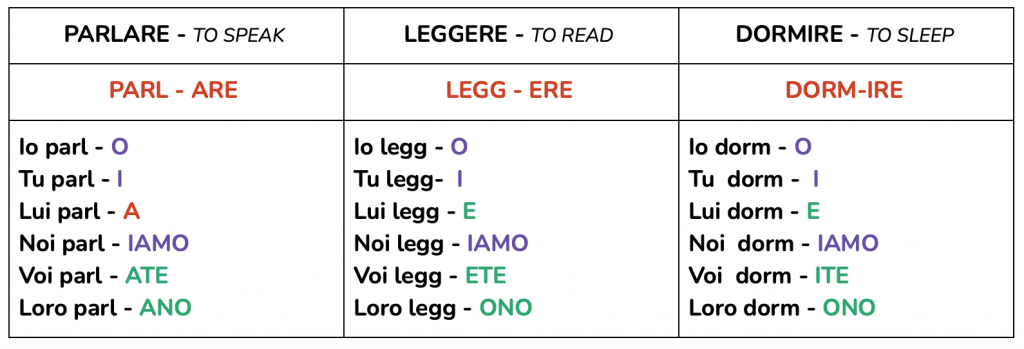What’s the present indicative tense in Italian?
The Italian present tense is used to describe what is happening now or to talk about a general truth (e.g. gli Italiani parlano italiano). It’s also used to say how long you’ve been doing something.
English vs. Italian
In Italian, the present tense can translate both the English simple present (e.g.I speak) and the English present continuous (e.g.I am speaking). So, if the forms appear hard, remember that the one tense will do two jobs for you.
English vs. Italian
In Italian, the present tense can translate both the English simple present (e.g.I speak) and the English present continuous (e.g.I am speaking). So, if the forms appear hard, remember that the one tense will do two jobs for you.
How to Conjugate the Present Tense in Italian
In Italian, unlike in English, there is a concept known as “conjugation.” It’s when the ending of a verb changes based on the subject of the action (e.g. the subject of an action can be I, you, she, etc.). Verbs in English are not conjugated since they must always be used with subjects.
The Italian present tense is formed by simply adding different endings to the verb’s stem. The stem of the verb is the part of the verb that remains after the classical ends of the infinitive *, which are, -ere, and -ire, are removed.
For example, in English, you say: I speak. The verb (speak) doesn’t change, but the subject “I” defines who is carrying out the action.
In Italian, we say parlO. The “o” ending is a first-person marker that indicates the subject of the action, which is “I” in this case.T
The 3 Conjugations of Italian Verbs
The infinitive form of a verb can be found by looking it up in the dictionary. The infinitive of many Italian verbs will end in the letters –are (the most common), -ere, or -ire. As a result, we may say that Italian has three groups of verbs, each with three different conjugations:
| Verb Groups | Infinitive Ending | Examples |
|---|---|---|
| 1st Group Verbs | -ARE | pensare, cucinare, imparare, parlare |
| 2nd Group Verbs | -ERE | leggere, scrivere, ripetere |
| 3rd Group Verbs | -IRE | dormire, aprire, sentire |
Note that the first-person forms all end in -o, which is the first person marker. The tu forms always end in -i; the noi forms always end in –iamo.

6 Tips for Using the Italian Present Tense Correctly
1. Understanding the subject object pronouns
The subject pronouns are io, tu, lui, lei, noi, voi, loro.
Important: the subject pronouns in Italian are almost always omitted. That’s why it’s crucial to choose the proper ending, the proper marker, if you want to get the right message across.
| Subject Pronoun | English Equivalent | Example Sentence |
|---|---|---|
| Io | I | Parlo italiano (I speak Italian) |
| Tu | You | Parli italiano? (Do you speak Italian?) |
| Lui / Lei | He / She | Lei parla italiano (She speaks Italian) |
| Noi | We | Noi parliamo italiano (We speak Italian) |
| Voi | You all | Parlate italiano? (Do you guys speak Italian?) |
| Loro | They | Loro parlano italiano (They speak Italian) |
2. How to make a negative sentence in Italian
One way to ask questions in Italian is to add a question mark to the end of the sentence in writing and to raise the pitch of the voice at the end of the sentence. The English helping verb “do” is not translated.
Examples
| Non parlo italiano | I don’t speak Italian |
| Non abito in Italia | I don’t live in Italy |
As you can see, the subject pronouns (io, tu, lui, etc..) are still omitted.

Test Your Italian
Not sure what your Italian level is? I’ve created a free online Italian test to help you determine it.3. Asking questions in Italian
To ask a question in Italian, add a question mark at the end of the sentence and raise the pitch of your voice at the end of the sentence. The English helping verb “do” is not translated (Do?, Does?, Did? can’t be translated).
Examples
| Abiti in Italia? | Do you live in Italy? |
| Parli italiano? | Do you speak Italian? |
4.Using the Present to Express the Future
The present tense in Italian can be used to express a future happening if it’s used together with an expression of the future (e.g. domani, il mese prossimo, tra una settimana).
| Lui va a New York tra una settimana | He’s going to New York in a week |
| Domani non lavoro | I don’t work tomorrow |
5. Irregular verbs
In Italian, just like in English, we have the concept of “irregular verbs”. These are verbs that do not follow the rules of conjugation for regular verbs.
The verbs “essere – to be” and “avere – to have” are the most frequent irregular verbs in the present tense. There are also a number of other irregular verbs that are rather prevalent.
A list of common Italian irregular verbs in the present tense
| Irregular Verbs | English Translation |
|---|---|
| Dire | to say, to tell |
| Dare | to give |
| Venire | to come |
| Andare | to go |
| Volere | to want |
| Potere | can |
| Dovere | must |
| Uscire | to go out, to leave |
| Rimanere | to remain |
Most common irregular verbs in Italian
6. The Italian courtesy form
The Italian courtesy form is used to express politeness to the other person in a conversation. Though it’s not a required form of speech, it is considered an important part of the language.
The Italian courtesy form is similar to the English “please” and “thank you.” We use the courtesy form, or “you polite” in Italian, when we consider it important to show respect to people we don’t know or don’t know well, older people, or people with a title (doctors, professors, etc..). The courtesy form is generally used in formal settings too.
The Italian courtesy form is made with the subject pronoun “Lei”, the third person singular.
Examples
| Question | English Translation | Setting/Formality |
|---|---|---|
| Parla italiano? | Do you speak Italian, Sir or Madame? [formal you] | Formal |
| Parli italiano? | Do you speak Italian? [informal you] | Informal |
| Vuole un caffè? | Would you like a coffee? [formal you] | Formal |
| Vuoi un caffè? | Would you like a coffee? [informal you] | Informal |








